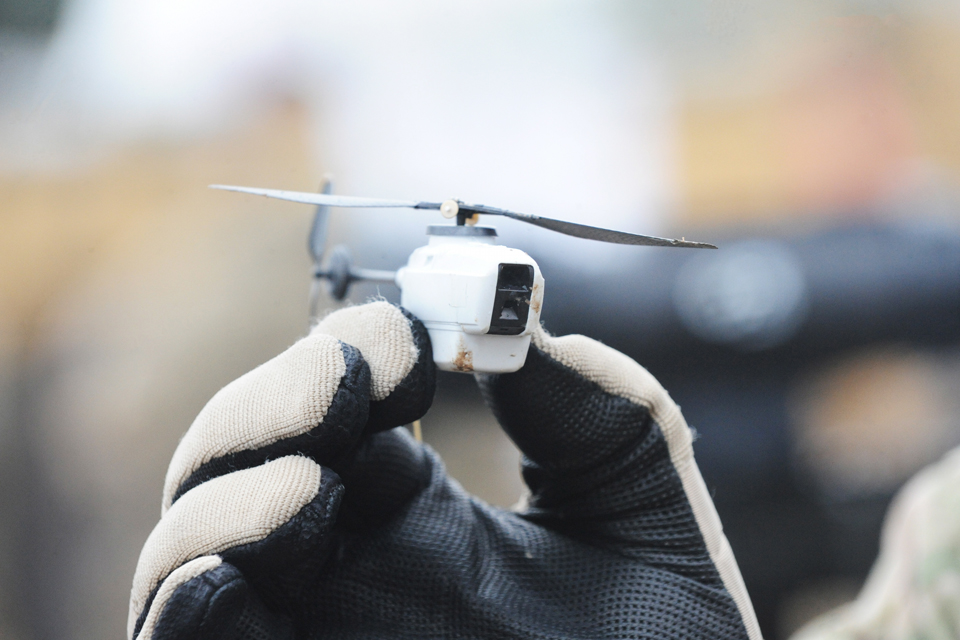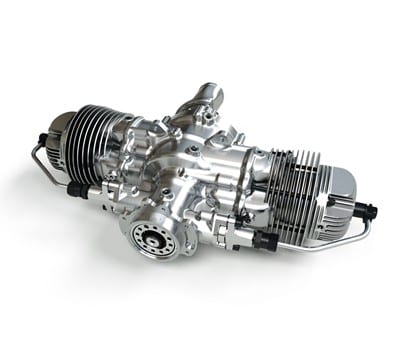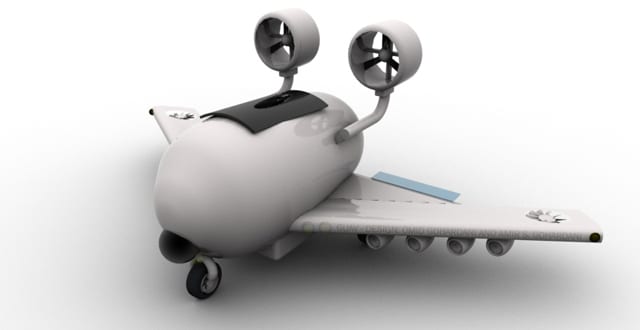 |
| (Photo: AeroVironment) |
An UAS is composed of the unmanned aircraft and all the relative support equipment, control station, data links, telemetry/communications/navigation equipment, etc, necessary to operate safely and efficiently the unmanned aircraft, which is the “flying portion” of the system. The ability to take on board sophisticated sensors and the ability to perform full automatic missions (i.e. following a pre-programmed flight profile and executed autonomously through the on-board systems) or by a pilot via GCS (Ground Control Station), make these systems particularly versatile and effective. The modern use of these aircraft stems from the need to perform particular missions defined “4D missions” (Dirty, Dull, Dangerous, Deep), and the high degree of sophistication in the areas of miniaturisation, lightweight airframes, advanced propulsion systems, secure data links, high technology control systems and payloads, have favoured the development of a new generation of efficient unmanned aircraft destined not only to reconnaissance but also to very delicate and difficult missions, opening new perspectives to the use of unmanned aircraft.
The last generation aircraft have been distinguished by the massive and effective use of advanced avionics and the application of intelligent systems, making the pilot, considered for his decision-making power and his capacity to intervene, absolutely indispensable. The only category of flying machines that is an exception to this rule (except, of course, the case of missiles) is that of UAVs, due to technological developments that gives them significant operational capabilities:
They can fly autonomously thanks to the pre-flight planning (but can be piloted from the ground both as an alternative and in the event of failures or malfunctions), the mission can be reprogrammed in-flight, are equipped with advanced sensors with all-weather and day/night capabilities, have excellent survivability thanks to their small size, limited RCS, low noise, minimum IR track and the use of shapes and materials typical of stealth technologies. There are various technological and operational reasons that led to the success and diffusion of these machines, such as the consideration that in particular circumstances in which the decision-making power and discretion of the pilot is not strictly necessary for the proper conduct of the mission, UAVs can be used with a more favourable cost/effectiveness ratio compared to the traditional man/aircraft combination. In fact UAVs are less expansive compared to a traditional aircraft and are unmanned, which implies that their possible shoot-down can be accepted fairly easily. In addition a consideration about the costs and time of formation/training of a pilot of a modern combat aircraft (especially if expressly dedicated to reconnaissance or electronic warfare) helps to understand how their loss is a risk, whenever possible, to avoid.
Modern UAVs are equipped with a full suite of sensors, selectable in function of the type of mission, factor that makes it available even for countries with limited economic resources (and limited experience in the field of advanced electronic) systems capable of carrying out not only reconnaissance but also EW, SIGINT and ELINT missions that could not be carried out with traditional aircraft because of lack of resources and know-how. Despite the operational evolution assigned to UAVs new roles and missions, ISR missions are still the most requested by land commanders. Persistent ISR refers to a sustained ability to gather intelligence from battlefield or other areas of interest through photos, videos and other sensors for the purposes of force protection, recognition, targeting, or damage assessment. Commanders utilising UAS surveillance can guide troops to safety or more advantageous tactical positions, direct fire and help identify landing zones for particular missions (such as medical evacuation). When such data is fed in real time to commanders the result can be really advantageous: this capability gives battlefield commander one of the most critical advantages over their enemies, because is possible to see a picture of the entire battlefield including friendly and enemy movements in real time.
Modern Armed Forces require for future unmanned systems the following characteristics:
- A full integration with manned aircraft across the full range of military operations;
- The use of automated control and modular payloads to maximize combat capability, flexibility and efficiency;
- Increased effectiveness and efficiency in order to use UAS where the human presence is a limitation to mission access;
- Operation in dangerous environments;
- The ability to fly over a target for long time periods with the opportunity to strike enemy targets (characteristic known as “persistence”);
- Integrates “find, fix, finish” sensor and shooter capabilities on one platform;
- Undetected penetration/operation capabilities;
- Advanced systems architecture to achieve security w/o fratricide;
- Airspace control resulting in safe/effective UAS operations;
- Provide capabilities more efficiently through modularity and interoperability;
- Be more effective through greater automation and greater performance;
- Be more survivable with improved and resilient communications; and
- Reduced number of personnel required to operate and maintain the systems (great strides in autonomy, teaming, multi-platform control, tipping and cueing have reduced the number of personnel required, but much more work needs to occur).
 |
| BLACK HORNET, a nano unmanned aerial system operated by the British Army (Photo: Sergeant Rupert Frere, Crown) |
Until today UAS were designed for specific missions, and it was difficult adapt them to changes in missions once built and deployed. The consequence is that industries and users have to maintain production and support lines for multiple UAS, all having different performance and sensors. New operational and logistic requirements have encouraged the development of multi-mission platforms, where two or three UAS designs serve as platforms that could readily adapted to a variety of different missions. The platforms would be differentiated by their technical characteristics, such as power plant, airframe, fuel capacity, with complementary hardware and software. When configured with the appropriate hardware and software, a small number of UAVs can be able to serve a wide variety of different and complex missions. A multi-mission reconfigurable platform has also positive influences on the entire life cycle cost, because design and implementation are more effective and there will be fewer UAVs model to support. Moreover, also the GCS can be more effective, thanks to a particular system known as Data Distribution Service (DDS) able to integrate controls and information displays, synthetic video and fused situational awareness data. It also allows users to connect multiple workstations, allowing a pilot at one station to work closely with a sensor operator at a different station. DDS systems decode data, analyse the UAVs operational situation, and interface to operator control, providing a fundamental approach to achieve advanced and integrated multi-mission UAS.
 |
| SCANEAGLE is an unmanned aerial system operated by several Armed Forces in the world. (Photo: Insitu) |
The increased use of UAV as weapon delivery platforms has been a significant step in the integration of these systems in the battlespace, and can be used in significantly different operating and threat conditions than manned platforms, and can exhibit greater persistence and endurance than traditional aircraft to support a large range of mission sets. Training is a critical link also in UAS capabilities, and the rapid expanding weapon system capability requires expansion in training simulation. This expansion will need improved simulation fidelity and integration with platforms for both effective/efficient use of resources.
 |
| Datron's SKYRANGER. (Photo: Datron) |
UAS: Design and Technology
Design requirements have facilitated the development of particular software destined for preliminary design of UAVs according to specifications, such as low detection, low noise and small size; and also as assistance to a more-detailed design (such as the sizing of the control surfaces according to the desired performance and the engine). This software makes possible:- Analysis of the requirements and general design choices,
- Setting and verification of studies on noise and RCS,
- Evaluation of structural and aeroelastic characteristics, and
- Detailed aerodynamic design (for example the study at low Reynolds numbers).
 |
| SKELDAR V-200 (Photo: Saab) |
Other fundamental capabilities may be deeply evaluated by modern software and intelligent systems. Interoperable interfaces for enhanced modularity and cross-domain data sharing present an opportunity to minimise future life-cycle costs, reduced force structure requirements, and adapt rapidly to changing threats or new available technologies. Military planners are calling for interoperability as a critical element to future unmanned systems. Interoperability will improve the ability for unmanned systems to operate in synergy in the execution of assigned task, and can serve as force multiplier, improve capabilities, decrease integration timelines, simplify logistics and reduce total costs.
 |
| RAVEN gimbal (Photo: AeroVironment) |
To achieve future goals, unmanned systems development and fielding must include the tasking, collection, processing, exploitation, and dissemination (TCPED) processes required to translate vast quantities of sensor data. The challenges that all UAS face include the availability of communication links, the amount of data that the communication links support, certification of the communication spectrum, and the resilience of all radio frequency subsystems against electromagnetic interference. Unmanned systems capacity requirements will grow with improvements in sensor technology and greater global distribution and will require an appropriate and flexible communication infrastructure, which in turn will require growth in the transport of multiplexed and multilevel classified disparate information. UAS data link capacities are expected to be capable of consolidating several high-bandwidth ingests and be network capable. On-board processing should also provide applications to compression, imagery frames per second and resolution in accordance with user capabilities. Moreover, communication of high mobile systems as UAV, require high-gain, rugged and effective multidirectional antennas, and may also use highly focused beams to achieve connectivity with more distant systems (GPS could be used to aid in this connectivity, also for Beyond Line of Sight Command and Control Link, i.e. the satellite data link communications used to fly the UAV anywhere in the world from the control station).
Advanced antennas are fundamental in communication systems and mission sensors: The developments in phased array antennas and “smart” antennas (including combining signals from multiple antennas) could offer an alternative to traditional antennas, and industry and military planners are also developing such techniques as multi-focused and super-cooled antenna systems. Future antenna system must be able to receive signals over a broad range of frequencies, but they also must be frequency selective. Therefore, phased array antennas are a viable approach. The utilisation of common apertures has called for the development of new interference mitigation methodologies that minimise interference effects and improve the characteristics of simultaneous transmit/receive operations within adjacent frequency bands.
The rapid development and deployment of UAS has resulted in a corresponding increased demand for more efficient, powerful and logistically supportable sources for propulsion and power. These propulsion system can be divided into three groups according to vehicle size and mission: Turbine engines, internal combustion, and electrical. Some of the parameters taken into consideration to determine the optimum propulsion system include size, weight, range, efficiency, and speed. Endurance is perhaps one of the most important aspect in UAS design, and the research continues for even more efficient systems to provide greater endurance, speed and range. Technical challenges include advanced materials and techniques to more efficiently recuperate energy while satisfying thermal and power requirements. These challenges are currently being addressed for UAS applications under the Highly Efficient Embedded Turbine Engine (HEETE) and Efficient Small-Scale Propulsion (ESSP) products, which are part of the Versatile Affordable Advanced Turbine Engines (VAATE) programme.
 |
| Cosworth's Lightweight Heavy Fuel Engine |
Reliability and maintainability are critical performance for UAS to accomplish their mission and to achieve required operational availability, and also on-board system must be simple to maintain and replace, especially in particular environments with little infrastructure support in which these system are used. The challenge is to achieve advanced system but simple and supportable by the operators and maintainers in the field.
The GCS (Ground Control Station) uses software interfacing immediately understandable by the operator, allowing an easy control of the UAV in real time. The UAV may return automatically or be diverted to another landing site (Mini- and Micro UAVs lands thanks to a mini-parachute or an airbag). GCS is a system of control/management of the mission that includes the following main elements:
- The MPCS (Mission Planning and Control System),
- The launch system, and
- Support systems.
The MPCS is certainly the most technologically interesting element. Heart of the MPCS is a sophisticated computer that manages the communication systems, modem and telemetry systems to receive communications, data and position relative to the UAV in every instant and, at the same time, send data relative to changes in altitude and/or speed, or the whole change of the flight plan. Also assigned to the MPCS system is the function of control/management/reprogramming of EW/ECM-ECCM systems through a dedicated channel. In case of ELINT/SIGINT or ESM missions, data detected on emissions can be transmitted to the support systems of the GCS. From here data is transmitted (and processed) via data link in real time to more complex management systems in very short time to get an overview of the situation of large areas with regard to the emissions of enemy systems and relative possibilities of jamming/neutralisation.
Key technologies in the development of future UAS are quantum computing, nano-electronics, robotics, nano-materials, alternative energy sources, and advanced modelling and simulation; able to lead to a real revolution in this field. The growth of unmanned systems for military and security use is projected to continue through the next decade. It is estimated that UAS spending will almost double over the next decade, from $6.6 billion to $11.4 billion on an annual basis, and the segment is expected to generate $89 billion in the next ten years. Greater range, better persistence, all-aspect stealth and improved battle networking make it possible surveillance/electronics/strike missions at any range, under any condition and against any threat.
 |
| The Generic Unmanned Air Vehicle, proposed by aerospace engineering experts. |
Engineer Paolo Quaranta is Deputy Head of the R&D Department of Advanced Aeronautical Technologies of the Italian CNR (National Research Council).
In this position he is leading research programmes in the field of technological application for military aircraft.
This article includes additional comments by the Editor.
This article includes additional comments by the Editor.








No comments:
Post a Comment